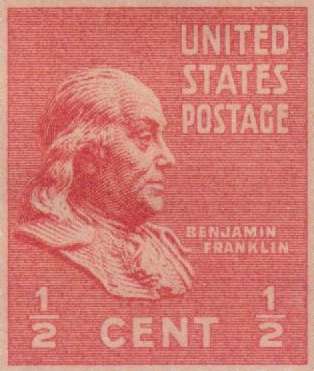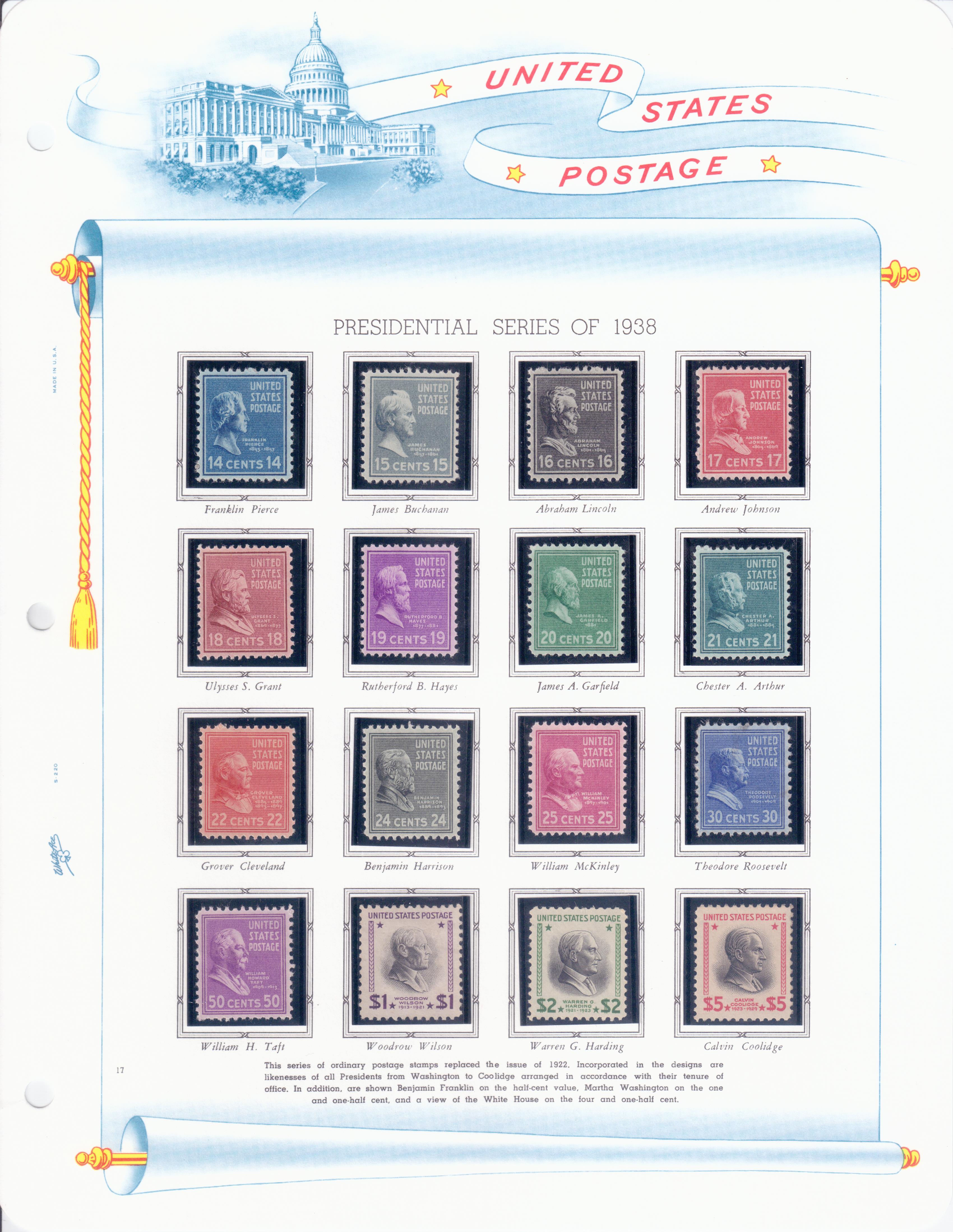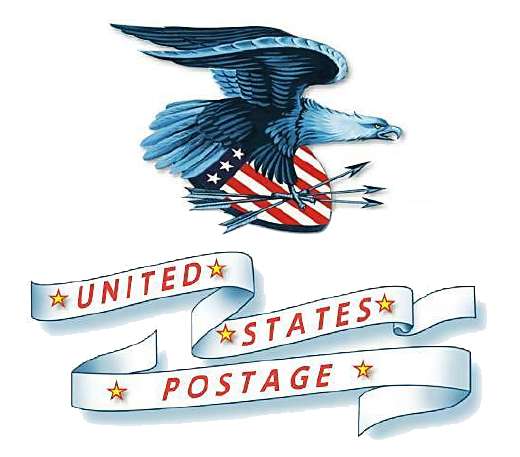Introduction: Stamps can be thought of as miniature works of art created by an imaginative designer. Regardless of the time period, the images on stamps display historically relevant information for the purposes of postal prosperity. Similarly, the showcasing of stamps by a philatelist on a collection page are just as much an expression of artistic imagination as the stamps themselves. Various arrangements require careful attention to symmetry, color coordination and representation, as well as an informative narrative.
Statement of Purpose: This White Ace Simplified Regular Issue collection captures the essence of nearly all major stamps issued from 1847 and continuing through to the present day. The collector who has assembled this collection wishes to remain anonymous, but nevertheless desires to exhibit the many displays so that other collectors can also appreciate the joys of the aesthetic approach.
Statement of Philosophy: The collecting philosophy is guided by several underpinning conditions, beginning with the inclusion of only cancel-free stamps, or ones in non-used condition, as much as possible. Yet, there are several instances where cancelations are included in some of the displays. It should be noted that it was not the initial goal to include every single imaginable color variety or variation of a particular issue, nor was the intention to be overly esoteric and restrictive, but instead to show select differences at the discretion of the collector. The entire collection philosophy allows for a type of nuance to allot for misunderstandings, misapplications, or errors on the part of the collector’s subjective interpretation. Such errors, though admittedly regretful, should not detract from the enjoyment one should experience upon viewing this collection. Troublesome stamp acquisitions are accompanied by certificates of authenticity.
Key Exceptions: Exceptions to the non-used condition rule include the intentional display of pre-canceled stamps, fancy cancels, sample overprints for post office identification or trial printings, as well as overprints - both international and domestic. Other exceptions include the inclusion of proofs of stamps on India, card or special gummed stamp papers. The rationale for these exceptions originates with the notion that the stamps on display need not be obscured by heavy cancelations so the designs are difficult to see in their entirety. Needless to say, many of the proofs included in this collection were printed around the same period as the issues themselves – meaning that color, impression and clarity are seen as originally intended. These exemplifications might not have been possible considering the premium necessary to acquire fresh looking, uncanceled stamps. Finally, there are several instances where commemorative stamps were included to illustrate similarity of design or for basis of comparison to a regular issued definitive stamp.
Counterfeits: Only one stamp in the collection is a known counterfeit – the yellow 10 cent George Washington coil from the 1908 to 1922 issues, which was altered by the collector to serve as a permanent placeholder because purchasing the original was beyond budget. Inclusion of this stamp does not violate the collection philosophy, but instead was included to maintain the goals of the aesthetic approach. Issues of 1847 are reproductions, and will be eventually replaced authentically.
Stamp Errors: This collection houses several iconic stamp errors that are beyond simple mis-perforations or color shifts common to modern printing techniques. The first set of errors shown are from the 1890-1893 issue, where plate deterioration during printing resulted in a “cap” on the left “2” on one of the 2 cent George Washington stamps, as well as two “caps” on both the right and left “2” of the same issue during a different printing. Also, from this issue are the “candle flame varieties” of the 1 cent Benjamin Franklin stamp. The second error, from the George Washington “heads” of 1908-1922, was a result of a misplaced plate during printing, rendering a 5-cent stamp instead of a 2 cent rose colored denomination. The presence of any additional errors in the collection are identified in the display design narratives.
Stamp Displays & Information Narratives: There are countless examples where the collector designed and created pages to capture variations or additions to collections not possible with the simplified regular issue displays printed by the White Ace brand (discontinued Winter of 2018). In that regard, these displays show additional colors, coils, coil pairs or strips of 4, imperforate and perforated variations, imperforate pairs, national & state pre-cancels, booklet panes (including various panes with slogans), booklet singles, as well as additional information. In several displays, stamps were inserted onto the original White Ace pages, without boarders around the mounts, to add interest and comprehensiveness to the design. These departures, both as minor as in the case of simply adding stamps to a previously made collection page; to major, as in the case of a completely redesigned page, result in some dramatic and impressive displays worthy of philatelic appreciation. Narratives added to contextualize such pages were either copied “as is” from outside sources or edited so that readers could gain some additional insight regarding the philatelic relevance related to the stamps. These “narratives” reflect the collective gathering of information from a number of different sources, and although are non-referenced, are not intended to be interpreted as original to the collector.
A Note on Catalogue Organization: Although this collector is well versed in the Scott catalogue system for stamp identification and organization, everyday individuals will not observe utilization of any Scott numbers in this collection. The reason being that the layouts on display are intended to be viewed by a lay audience, or persons who might not be entirely familiar with the complexities of the Scott catalogue. However, those with knowledge of the system will be pleasantly surprised to discover that most of the auxiliary stamps shown have been selected based on criteria and collection logic found within the confines of the Scott numbering system.
Other Considerations: Although this collection does include scarce, expensive and difficult-to-acquire issues, it is by no means the panacea to a collection with flaws, faults or substantive drawbacks. Perfect, or “mint,” collections exist only for those who define excellence as including stamps with full gum, ones that have never been hinged, or only well-centered stamps. Even with those types of restrictions, such collections might never attain completeness over the lifetime of the collector – not to mention that for the most part they are unattainable financially. This collection on the other hand, offers beautiful looking stamps that might be considered flawed by strict guidelines or otherwise untenable standards. Upon further investigation, one might arrive at the conclusion that what really counts when seeking to foster aesthetic appreciation is what can be directly seen - the front part of the stamp. That is not to say that stamps that were affected by mold or other forms of damage, such as age-related deterioration, serious flaws, poor centering, thins, discoloration or oxidation, were included. In that regard, every attempt was made to select stamps with as few physical imperfections as possible in order to preserve their integrity for future generations to view, enjoy or sell.









